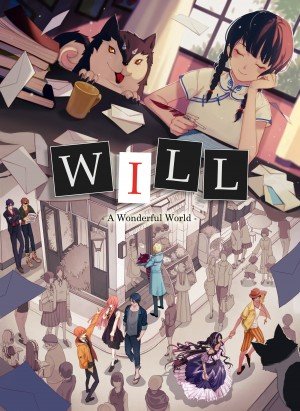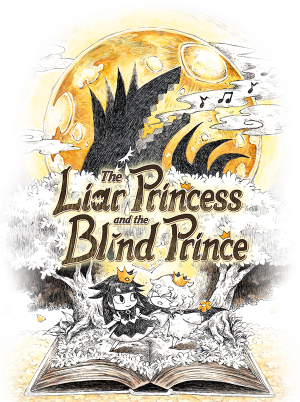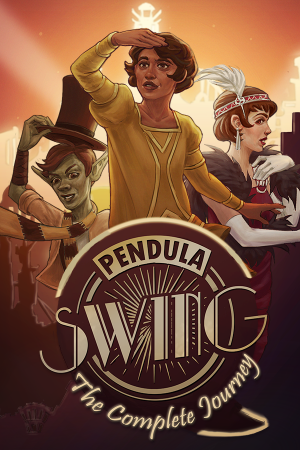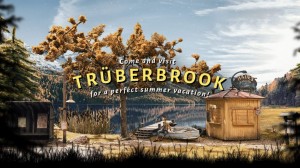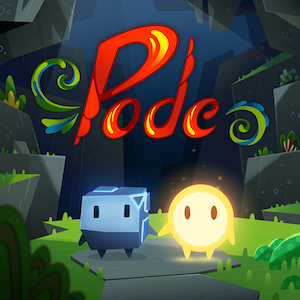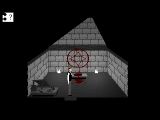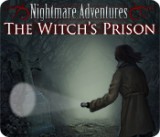Review for The Antidote
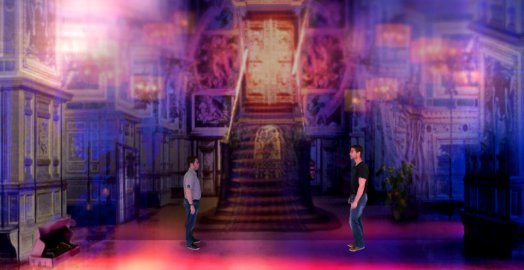
It’s no secret that video games tend to provide some of the best forms of escapism. Whether journeying through a fantastical world or beating the ever-loving crap out of an opponent to vent frustration, games can take us all sorts of places and do it all. The Antidote provides a different form of escapism, however, in the form of a mystery-comedy as told through a drug-filled haze, filled with trippy visuals, brain-exercising puzzles and unique character interactions. It’s a little rough around the edges, but if you’re looking for a fix of weird, challenging but ultimately fun bit of adventuring, this indie point-and-click title might just be the dose you need.
The Antidote is about an honest, blue-collar worker named Roger who wakes up in a strange castle after being knocked unconscious and injected with a hallucinogenic drug by an unknown assailant. He soon meets another victim, Barry, who tells him there’s apparently an antidote to the drug somewhere deep within the keep. Thus begins Roger’s psychedelic adventure as he attempts to find out more about the castle and just who the villain is behind this twisted conspiracy, as well as how he himself fits into all this.
The initial abduction premise is interesting enough, with a very down-to-earth and relatable character who gets swept up in this mysterious, almost Saw-like scheme. The goal is very straightforward, so from the outset the game knows what it wants to do narratively, which helps keep the story focused. In between points A and point B, however, are plenty of surreal and humorous predicaments that stem from Roger being drugged out of his mind, and even a few supernatural moments that make you question whether it is all because of the hallucinations or if you really are dealing with paranormal entities. The answers are kept vague even to the very end, which makes the entire series of events more interesting to reflect on once the story is complete.
Don’t think about it too hard though, because The Antidote is largely intended to be an absurdist comedy that comes from its many bizarre character interactions. Although Roger himself is a little bland, his blissful acceptance of what happens around him and his occasional acknowledgement of being in an adventure game are enough to afford him some moments to shine. But it’s the supporting cast that is especially unorthodox, including a civil war re-enactment enthusiast ghost and his nagging spirit wife. Your fellow captive, Barry, only shows up a few times throughout the whole affair, so the most talkative and recurring NPC in the game is a wishing well who’s tired of everyone throwing coins down its hole.
The whole adventure is filled with quirky jokes and unique puzzles that keep the experience memorable for the most part. It’s an odd style of humour, but it’s written well enough that the script is “funny weird” and not “eye-rolling weird”, like Roger basically being forced to punish a chained-up masochist who won’t help unless he’s properly hurt, or assisting a spectre who doesn’t want to join his wife in the great beyond because he’s having an affair with another ghost. There are a few typos in the subtitles, but overall the translation seems fairly polished.
Even with all its comedic touches, The Antidote could almost be mistaken for a psychological thriller at points, since you’re playing the victim of a deranged individual and both the graphics and sound contribute to a somewhat unsettling atmosphere at times. The combination of creepy and funny never seems to clash, fortunately, with the jokes helping balance the experience from ever becoming too dark or serious. This makes the overall atmosphere here a unique one that contains shades of both spooky mystery and sarcastic humour.
There are numerous locations to explore within the castle, ranging from a weapons room, an old library, a dining hall, and even a torture chamber, for a total of 13 unique areas, some bigger or smaller than others. All of them are visually distinct from one another, but are thematically consistent to give the impression of an interconnected structure.
The presentation is certainly striking, with visuals based on actual photos of people, places and things, harkening back to the mid-nineties when FMV games were all the rage. What really makes them stand out here, though, are the funky filters, warped effects and occasionally odd perspectives used, which further drive home the trippy, drug-induced atmosphere. The scenes are layered with varying colours and can be twisted and distorted, with edges turned into wavy lines and details blurred together in an attempt to replicate what one might see under the influence of psychotropic drugs.
Thankfully these filters are limited to mostly cool hues like purples and blues, with a few warmer colours mixed in, but they may still be a turn-off for some players. A bigger problem is that they can occasionally get in the way of gameplay, obscuring or hiding objects in plain sight that are meant to be interactive. Even without any distortions, some objects are farther back from the player’s point of view, making they harder to spot. Such issues can lead to a few moments of pixel hunting for small hotspots, such as a pen that is easy to miss the first time because it is blended into the rest of a desk.
The Antidote doesn’t have much in the way of animation other than the human characters and their 3- or 4-frame walk cycles, but this is hardly noticeable in context. There are occasional cutscenes made up of a series of still images, but the photos used in these scenes aren’t altered like the in-game backdrops, leaving them clean and pleasant to look at. They tend to display characters that are overly expressive, injecting just the right amount of cheesy peculiarity.
Coupled with the esoteric and occasionally disquieting visuals, the audio direction also helps accentuate the enigmatic nature of this adventure. The music is downplayed much of the time, which means a lot of slow, deep-toned synth tracks. Between puzzles and conversations, the score feels eerie and leaves you with a sense of loneliness in traversing this large, empty castle with few signs of life, but when it comes to solving puzzles or talking to others, the music is subtle enough that it blends into the background to give way for some of the quirkier moments.
The sound effects, like the music, are generally understated, leaning more towards the side of realism, but there are so few of them in the first place that they aren’t particularly noticeable. There isn’t any voice acting either, which is a shame, as it seems like a missed opportunity to introduce some wonderfully hammy performances that characterize the best B movies (and games). Unfortunately, you can’t skip through the dialogue line by line, as both a mouse-click and tap of the space bar simply take you straight to the end of the current conversation (at least some of the time).
The Antidote’s overarching plot is bare-bones, except when it gets a little more exposition-heavy near the very end. On the flipside, the castle is filled with interesting and often perplexing puzzles that go beyond the typical ‘combine these items together’ or ‘say the right thing to the right NPC’ formulas, though there are still elements of those. A lot of puzzles demand interacting directly with the environment in creative ways. Some require recalling small details like dates or names that only get mentioned in specific places, so it’s best to take some notes from items you can’t take with you. One such object is the “Book of Useless Facts” that Roger finds early in the game, which ironically becomes the most useful item as you’ll be going back to flip through it often.
The challenges here are not for the impatient, as there are several that require you to stop and think, such as using the periodic table to decipher a number lock. If there’s a criticism, it’s that this game can be quite obtuse when it comes to puzzle solutions, such that even adventure game veterans could struggle with some of them. I ended up needing a walkthrough to overcome certain obstacles, especially in the second half of the game. Some of them aren’t illogical per se, making certain sense in hindsight, but solving them feels like a total shot in the dark beyond the occasional very vague hint – if they can even be called that, such as constructing a makeshift fuse with no more indication of what’s needed than Roger saying “it’s too dark to see.”
Rarely does the game spell out solutions, and while that may be off-putting to more casual players, solving the puzzles that are properly clued is immensely satisfying and one of the best parts of the experience, although the ones relying more on perseverance and trial-and-error, not so much. The developers might be aware of this, as they’ve posted their own guide on the Steam community forms, but making the puzzles less cryptic and the clues more relevant would’ve been a better alternative.
The game glosses over its own tutorial, further adding to the not-newbie-friendly complaint, but the interface is another nostalgic throwback to classic Sierra, with verb cursors that can be selected from a bar at the top of the screen or cycled through using the right mouse button. The left button is reserved for confirming actions and navigating dialogue trees, which players should explore fully. The different verbs can also be cycled through using the WASD and X keys, which should be kept in mind as there are a few times when the right mouse button abruptly ends up being reserved for an action that can’t be switched; in these cases the hotkeys or the menu bar become the only options.
One of the most helpful features is the ability to pull up a map of the castle and fast travel to any previously visited location. The already complex puzzles do require going back and forth between areas sometimes, so this convenience helps expedite the process. The menu also has a “game speed” option that increases Roger’s walk speed, so crank that slider to the max if his initial pace is too slow for you. Another useful hotkey is Tab, which brings up Roger’s inventory that you’ll be opening often to solve puzzles. Once an inventory item is selected, it will become part of the right-click cycle to use in the environment or combine with another object.
Technically speaking, The Antidote runs fairly smoothly and can easily be played on most modern PCs. The game allows for customized settings like resolution size, mouse speed, and extra graphical and sound options. Note: don’t Alt-Tab out while playing, as the music will keep going but continue to stutter until you restore the game. The only other glitch I came across was the Steam notification in the bottom corner visually glitching, which is easily fixed by opening the overlay and closing it again.
In the end, The Antidote ends up being a very weird, yet surprisingly funny and challenging throwback to older FMV-era adventure games. Its strange visuals coupled with an unsettling atmosphere and lighthearted script are certainly an odd mix, but they succeed in creating a rewarding journey overall. It’s a little on the tough side due to some pixel hunting and a lack of sufficient clues, which is the only thing padding out what would otherwise be a short two-hour experience, but if you want a game that’ll test your wits and has a unique psychedelic style, this little indie title does enough good things to recommend.



_capsule_fog__medium.png)








